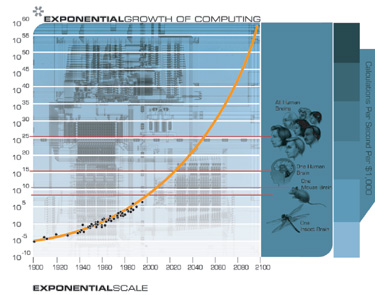Innovative computer tech for the next boom
December 11, 2001 | Source: KurzweilAI
Which innovative technologies will spur the next boom? That was a key question on the minds of executives attending the recent BusinessWeek Conference on the Digital Economy in San Francisco.
For consumers, seamless access to information will drive the future of the computer industry, according to Daeje Chin, president and CEO, Digital Media System Business, Samsung Electronics. For businesses, it will require seamless access to devices –- home, office and mobile. This will be achieved by “digital networked convergence,” incorporating better interactivity, voice and visual recognition, and human-like thinking, he said.
A new wave of personal handhelds will play a major role in achieving this convergence, said David Nagel, President and CEO of Palm’s Platform Solutions Group. They will combine communicator, digital phone, email, and personal organizer functions. “The next step is to network all those” in local and wide area networks, he said.
Pradeep Sindhu, Vice Chairman, CEO, and Founder, Juniper Networks, agreed that networking is key. The killer app in networking will “allow every computing device in the world to connect to any other device at any time in a secure way.” This will be achieved with the “new Internet,” which will be the carrier of all commmunications and information in the physical world,” he predicted.
“The emergence of intelligence in human beings offered us a differential survival advantage in the physical world,” he pointed out, and the Internet will offer a similar advantage.
Browser inventor Marc Andreessen, Chairman and cofounder, Loudcloud, agreed that the Internet will be at the core of successful future IT strategies.
The ultimate company would have “instantaneous access to all the information it needs whenever it needs it, know exactly what its customers and suppliers are thinking and what’s happening throughout the world,” he said.
“IT will have to prepare for all of the new apps they will have to bring online in the next five or ten years, make infrastructure much more resilient and do that in an environment of very tight budget controls and active cost cutting.
“It’s going to be will be impossible to meet all these challenges with the status quo approach to managing IT organizations,” he warned, which are staffed and funded for the near term, forcing them into a reactive, ad hoc frame of mind. “Companies will have to take a more proactive stance” to deal with an uncertain world.
He advised CEOs to think of their IT organizations as strategic information utilities, planned out ahead of time. We may need to turn to service providers who can outsource these services or get help doing it internally, he said.
Hewlett-Packard Vice President and CTO Richard DeMillo said HP’s strategy for delivering the information utility is called “service-centered computing.” He also described HP Labs-based transformational “Cooltown” technology to allow smart devices to “click into an open communications fabric and access resources in a completely natural way.”
DeMillo also said nanotechnology will be essential to help propel us beyond the limits to Moore’s law. He said HP has patented a technology for linking together switching elements at the molecular scale.
“In 20 years, most computer technology will be nanotechnology,” said futurist/author Ray Kurzweil.

Kurzweil: exponential growth
By 2030, software will reach the level of human intelligence by decoding the functions of the human brain, he said. “We will have fully reverse-engineered the human brain and have detailed models.”
We will further expand human intelligence and share knowledge by introducing nanobots into the brain that will communicate wirelessly via the Internet, he predicted.
“The pace of change itself is accelerating. We’ll see 20,000 years of change over the next century.”
